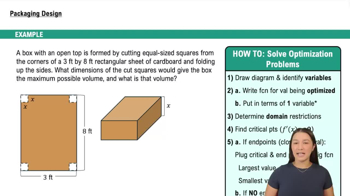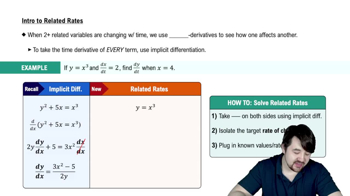Watching an elevator An observer is 20 m above the ground floor of a large hotel atrium looking at a glass-enclosed elevator shaft that is 20 m horizontally from the observer (see figure). The angle of elevation of the elevator is the angle that the observer’s line of sight makes with the horizontal (it may be positive or negative). Assuming the elevator rises at a rate of 5 m/s, what is the rate of change of the angle of elevation when the elevator is 10 m above the ground? When the elevator is 40 m above the ground? <IMAGE>
Table of contents
- 0. Functions7h 54m
- Introduction to Functions16m
- Piecewise Functions10m
- Properties of Functions9m
- Common Functions1h 8m
- Transformations5m
- Combining Functions27m
- Exponent rules32m
- Exponential Functions28m
- Logarithmic Functions24m
- Properties of Logarithms36m
- Exponential & Logarithmic Equations35m
- Introduction to Trigonometric Functions38m
- Graphs of Trigonometric Functions44m
- Trigonometric Identities47m
- Inverse Trigonometric Functions48m
- 1. Limits and Continuity2h 2m
- 2. Intro to Derivatives1h 33m
- 3. Techniques of Differentiation3h 18m
- 4. Applications of Derivatives2h 38m
- 5. Graphical Applications of Derivatives6h 2m
- 6. Derivatives of Inverse, Exponential, & Logarithmic Functions2h 37m
- 7. Antiderivatives & Indefinite Integrals1h 26m
- 8. Definite Integrals4h 44m
- 9. Graphical Applications of Integrals2h 27m
- 10. Physics Applications of Integrals 3h 16m
- 11. Integrals of Inverse, Exponential, & Logarithmic Functions2h 31m
- 12. Techniques of Integration7h 41m
- 13. Intro to Differential Equations2h 55m
- 14. Sequences & Series5h 36m
- 15. Power Series2h 19m
- 16. Parametric Equations & Polar Coordinates7h 58m
4. Applications of Derivatives
Related Rates
Problem 3.11.33
Textbook Question
Piston compression A piston is seated at the top of a cylindrical chamber with radius 5 cm when it starts moving into the chamber at a constant speed of 3 cm/s (see figure). What is the rate of change of the volume of the cylinder when the piston is 2 cm from the base of the chamber? <IMAGE>
 Verified step by step guidance
Verified step by step guidance1
First, identify the formula for the volume of a cylinder, which is given by: , where is the radius and is the height.
Since the radius is constant at 5 cm, the formula simplifies to: .
To find the rate of change of the volume, differentiate the volume formula with respect to time . This gives: .
The problem states that the piston moves at a constant speed of 3 cm/s, which means is 3 cm/s.
Substitute = 3 cm/s into the differentiated equation to find the rate of change of the volume: .
 Verified video answer for a similar problem:
Verified video answer for a similar problem:This video solution was recommended by our tutors as helpful for the problem above
Video duration:
3mPlay a video:
Was this helpful?
Key Concepts
Here are the essential concepts you must grasp in order to answer the question correctly.
Volume of a Cylinder
The volume of a cylinder is calculated using the formula V = πr²h, where r is the radius and h is the height. In this scenario, the radius is constant at 5 cm, while the height changes as the piston moves. Understanding this formula is essential to determine how the volume changes as the piston compresses the air in the chamber.
Recommended video:

Example 5: Packaging Design
Related Rates
Related rates involve finding the rate at which one quantity changes in relation to another. In this problem, we need to relate the rate of change of the volume of the cylinder to the rate at which the height of the piston changes. By applying the chain rule, we can express the rate of change of volume in terms of the rate of change of height.
Recommended video:

Intro To Related Rates
Differentiation
Differentiation is a fundamental concept in calculus that deals with finding the rate of change of a function. In this context, we will differentiate the volume formula with respect to time to find the rate of change of volume as the piston moves. This process allows us to calculate how quickly the volume of the cylinder is decreasing as the piston compresses the air.
Recommended video:

Finding Differentials

 4:16m
4:16mWatch next
Master Intro To Related Rates with a bite sized video explanation from Patrick
Start learningRelated Videos
Related Practice
Textbook Question
